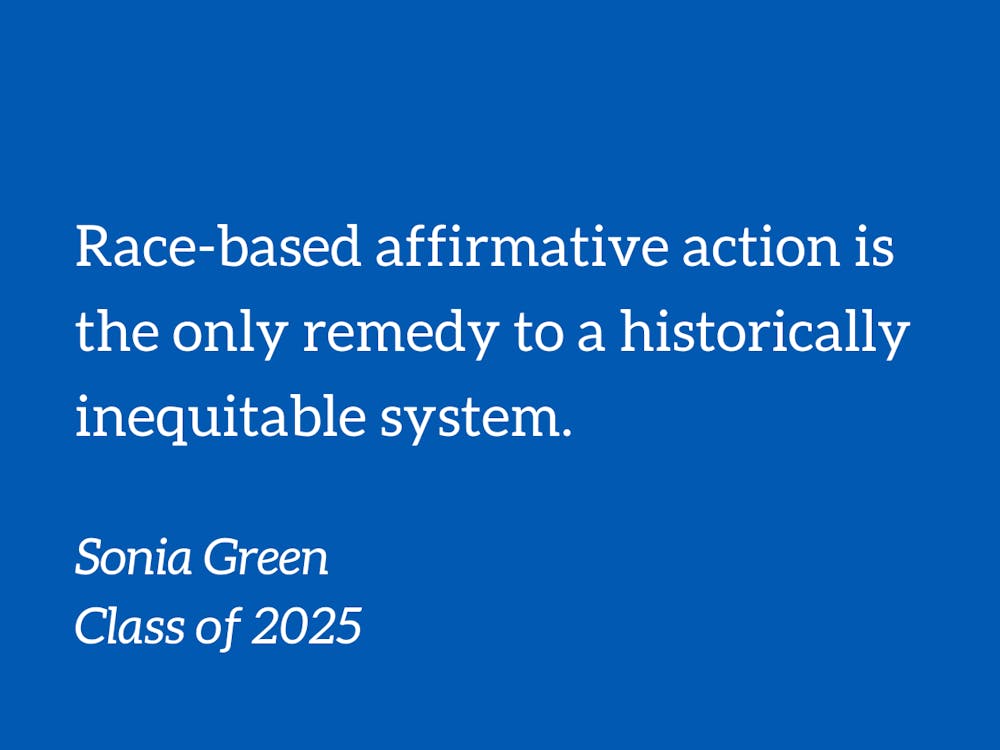With the striking down of affirmative action over the summer, I had assumed the debate was over. Conservatives won, and Black students — as we often are — were left to grapple with what this new legislation would mean. We came back to Duke and many students moved on with their lives as if nothing had happened. I was hesitant, however. I didn’t know what this meant for my community and as I navigated campus, I constantly wondered who was on “our side." It turns out that this debate on affirmative action is bigger than I could have ever imagined even though the concept is quite simple. Affirmative action policies aim to achieve and maintain racial diversity in higher education and give opportunities to a diverse group of people. What exactly is wrong with that? The era of segregation was not that long ago, and barring Black Americans from schools like Duke did not depend on class but race.
I must preface by stating that while affirmative action policies serve Black, Latinx and Native American students, I will be focusing on their impact on the Black community, as that is the one I am a part of. The affirmative action debate boils down to the question: Is it ethical to give some marginalized communities an advantage even if it seemingly disadvantages other groups? I argue yes. To understand why, it’s important to look at history.
The United States was built by Black people who were provided little to no compensation for their labor. Even after slavery and segregation were legally overturned, Black Americans were still not provided the same access to the institutions their labor had built. This is at the heart of the affirmative action issue. While Black Americans were subjected to de facto segregated schools with lower-quality resources and almost no access to college or higher education — especially at elite institutions like Duke — white Americans went to better schools and colleges. They built wealth and gained knowledge which they passed to their offspring.
In order to really understand affirmative action, one must understand the communities it serves to uplift. Students of color coming from lower-income and under resourced communities are more likely to fare worse on metrics that colleges use to evaluate applicants. These resources vary greatly among racial lines, especially considering that the poverty rate for Black Americans — at 17.1% — is double the the poverty rate for Asian and white Americans, the latter at 8.6%. Income alone cannot replace race in admissions criteria as long as this racial wealth gap — caused and upheld by a history of structural racism — exists.
I’d like to point out real-life examples of instances in which affirmative action has “worked”. Dr. Henry Louis Gates Jr., historian and professor at Harvard University, states that without affirmative action, he would not have gone to Yale University, his alma mater. This was clearly not due to a lack of academic ability; Dr. Gates is now a revered figure in academia and the documentary world. He said this because without affirmative action he would have never had the opportunity.
Even Clarence Thomas, one of the Supreme Court justices who helped overturn affirmative action, is also believed to have benefitted from this practice. These two figures have, regardless of their politics, gone on to create successful careers that they simply may not have had access to without these affirmative action policies in the 1960s and 1970s. These same policies are still relevant today, only a few decades later.
Now, people argue that race-based affirmative action is no longer necessary because adding value to race sets us back. I wholeheartedly disagree and argue that this thinking comes from a point of privilege. Elite colleges and universities have a history of race-based exclusion, and this legacy can still be seen today. Take Duke as an example: White and Asian students make up over half of the population on campus while Black students only make up about 7%. Whenever I walk around campus, it is easy to spot a student who is white or Asian, but I am struck by how many times I have been places and struggled to see another Black peer. This has happened on the C1, in classes, in WU and in many other spaces.
Additionally, many white students and Asian students are familiar and/or comfortable with interacting with each other in a way that they are not with Black students. There is no reason why students should be scared of me when I ask them to respect quiet hours while in a common area or act uncomfortable when they are told they cannot use the occupied Black Student Alliance (BSA) office to join a private Zoom meeting. Black students are constantly seen as a group to be feared or a spectacle to be carefully observed on campus because for many Duke students, this is their first real interaction with Black people. How should we feel?
To those who are still not convinced that we need race-based affirmative action, I challenge you to think about how many people in your family attended Duke or a similar institution. What about your high school? What about your community? I have often noticed that the students who are most upset by race-based affirmative action already have a lot of exposure to elite institutions. Race-based affirmative action is the only remedy to a historically inequitable system. Arguing that race-based affirmative action is no longer needed is like arguing that we can right the wrongs of an entire racist system in just a few generations. It’s naive at best and that is not something we can afford to be.
Sonia Green is a Trinity junior. Her column typically runs on alternate Tuesdays.
Get The Chronicle straight to your inbox
Signup for our weekly newsletter. Cancel at any time.

